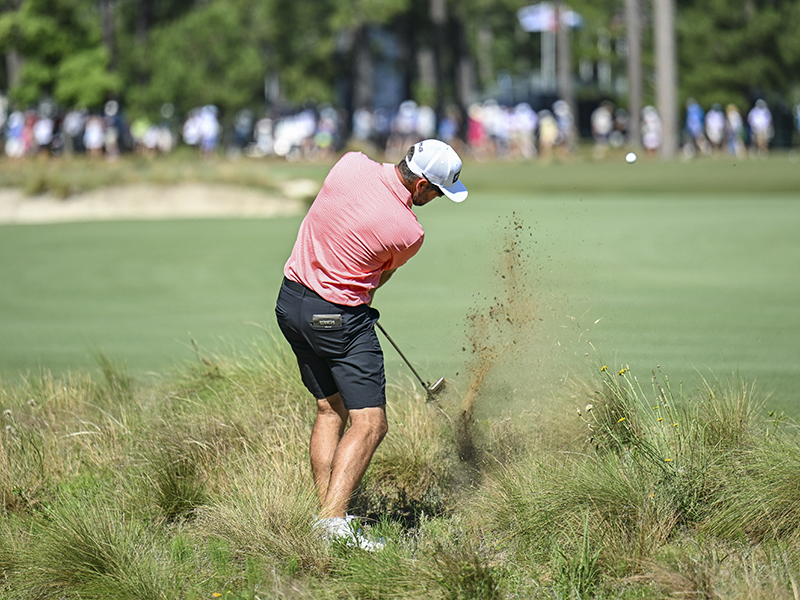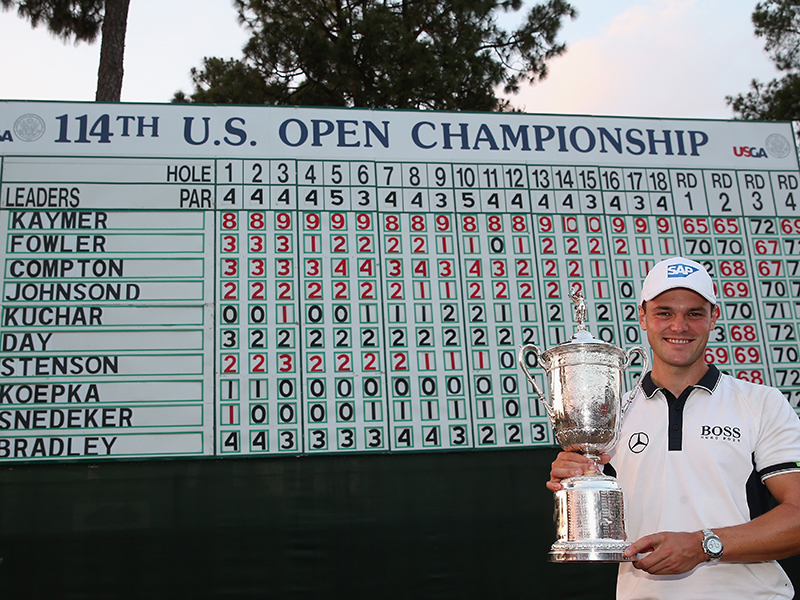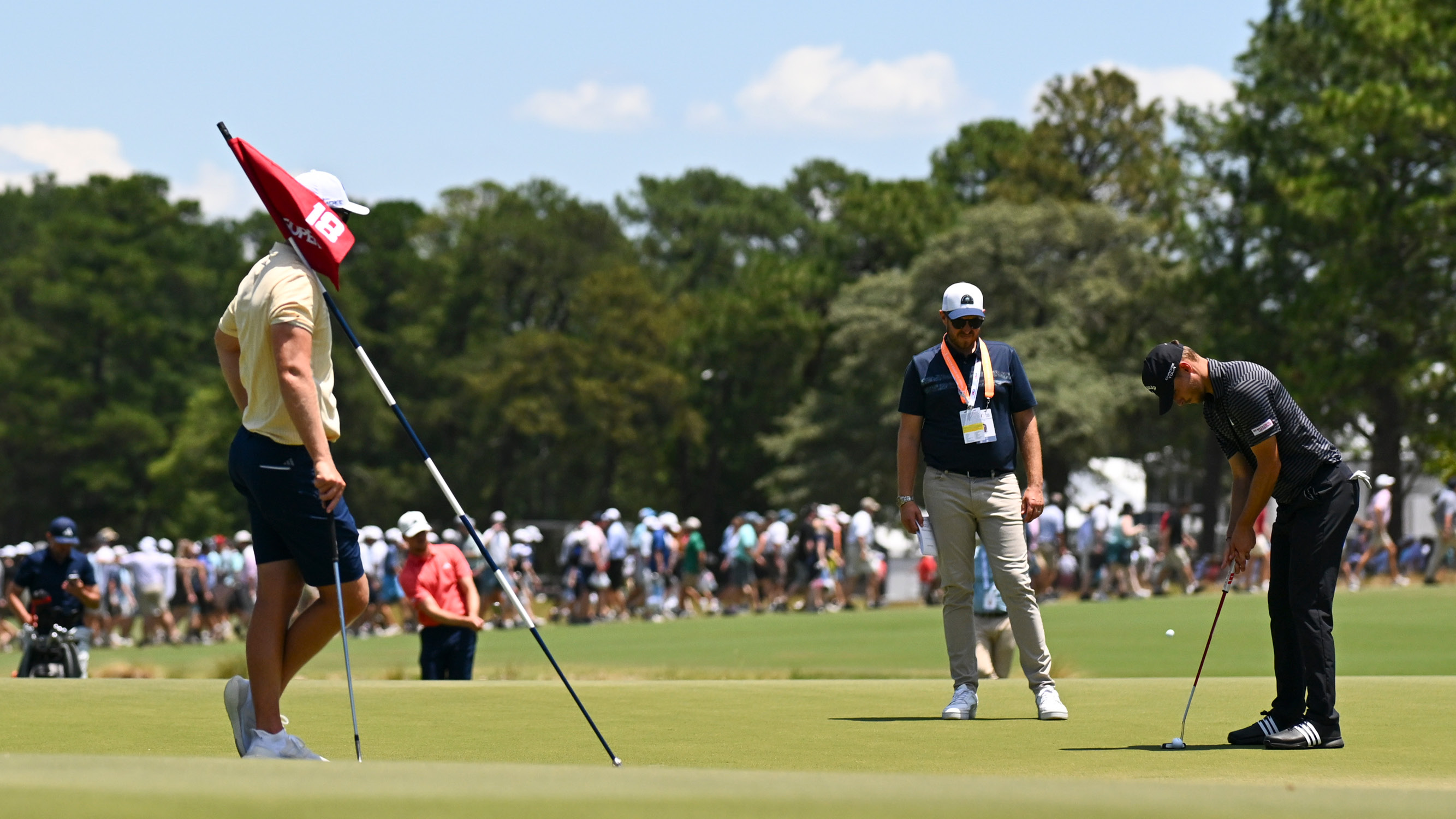The US Open is NOT Too Hard... Anyone Who Thinks So Has Lost Their Grip On Reality
Balls rolling off the green, tricky lies and plenty of danger... Pinehurst No.2 is a real US Open course that will stand up to the birdie brigade


Pinehurst No.2 is already proving to be a bit of a brute, and so it should be! US Open golf, and Majors in general, should be fiendishly hard and players should have to work for the right to hoist the trophy on Sunday.
The PGA Championship was won by Xander Schauffele at a quite frankly embarrassing score of 21-under-par, making it the lowest score ever in Major Championship history.
A combination of course conditions and set-up allowed Schauffele to shatter low scoring and course records, making a mockery of what these tournaments are supposed to represent.
In order to become a Major champion you should not only have to beat your fellow competitors, but also overcome the course, and Pinehurst No.2 could just be a worthy foe...
Why The US Open (And All Majors) Should Be Hard...
So far this season, 19 of the 25 PGA Tour events (excluding the Zurich Classic) have been won at a score of 15-under-par or better. Nine of those have actually surpassed 20-under-par, with two reaching the dizzy heights of 29-under-par.
The signature events have also followed a similar pattern, with six out of seven so far this season being won at 15-under-par or better. The Players Championship, the flagship event on the PGA Tour, hosted on an iconic golf course at TPC Sawgrass, saw Scheffler snatch victory at 20-under-par, further amplifying the lack of diversity in the levels of challenge.
I am not saying there isn't a place for 'birdie-fest' golf, but the regularity in which we see it risks making the sport dull. Last week's set-up at the Memorial Tournament created just enough jeopardy on Sunday to make it interesting, and actually my favourite event of the season so far to watch.
Get the Golf Monthly Newsletter
Subscribe to the Golf Monthly newsletter to stay up to date with all the latest tour news, equipment news, reviews, head-to-heads and buyer’s guides from our team of experienced experts.
At the very least, the four events each year that comprise the men's Majors should be the true tests in our sport – requiring players to scrap, scramble and battle for par.

Chris Kirk won The Sentry at 29-under-par in January 2024
An important caveat to that point is around The Masters, which is unlikely to ever be a tournament where par is a good score again, but we love it all the same as it has identity. The US Open also has an identity... that it's ruthlessly hard.
Pinehurst No.2 has already promised to meet that standard. Social media clips and interviews with players have suggested that the tricky 'turtleback' greens, sharp run-off areas and unpredictable landscape could create the perfect conditions for a true slog in the sun.
But, why is it important that we see that? In adversity and challenge, we witness a lot about a players true skill level, temperament, strategy and creativity, rather than the same weekly process of throwing darts at flags and having 10ft for birdie.
The jeopardy on approach at a lot of tour venues is nullified by thick rough around the greens, which most elite players are capable enough to navigate with relative ease. The shaved run-off areas and slick greens at Pinehurst No.2 will insist that players get creative in their shot-making, using a variety of clubs throughout their bag to manufacture a little magic.

Corey Conners hitting a shot out of a tough lie at Pinehurst No.2, in preparation for the 2024 US Open
Its length also doesn't necessarily play into the hands of the 'bombers' off the tee, with strategy playing a crucial part in determining the right angle to approach the green. While distance will be important this week, I'd be surprised to see anyone pulling driver on every tee box – again adding another tactical dimension to proceedings.
Clearly there is a balance to find in ensuring the difficulty doesn't cross that borderline between resistant and ridiculous, as nobody wants to see controversies where the best players in the world are reduced to apparent hackers. Pinehurst No.2 has a great record of meeting that brief, with the winning scores from its first two times hosting the event coming it one-under par (1999) and even par (2005).
Martin Kaymer dared to rebel against it in 2014, shooting by comparison an alarmingly high nine-under-par, but when you consider the joint runner-ups finished on one-under-par, you can perhaps forgive that blemish as a one-off demonstration of genius from the German.

Martin Kaymer with the 2014 US Open trophy, standing in front of a leaderboard where only three players shot under-par for the week
The US Open, and in turn the USGA, perhaps have the best record of setting up tough Major tests, with three of the last four winners of this event doing so at single figures under par.
While you might hear one or two (but likely many more) players complaining this week, I certainly won't be. As a regular golf viewer, I want to see a blend of different types of golf course, a variety of challenge and opportunities for an array of different winners, but I believe the stiffest tests should be reserved for weeks just like this.
Some will claim that the test is 'unfair', but seeing as the challenge is the same for every player I find it hard to agree with that sentiment. Variation is good for the game of golf, and while I know there will be people who disagree with my position, I will be furious if I see the leaders score rising anywhere near the absurdity of the previous Major championship.

Barry joined Golf Monthly in January 2024, and now leads the instruction section across all platforms including print and digital. Working closely with Golf Monthly's Top 50 Coaches, he aims to curate and share useful tips on every aspect of the game - helping amateurs of all abilities to play better golf. A member at Sand Moor Golf Club in Leeds, he looks forward to getting out on the course at least once a week in the pursuit of a respectable handicap.
Barry is currently playing:
Driver: Benross Delta XT Driver
Hybrid: TaylorMade Stealth 4 Hybrid
Irons: Benross Delta XT 5-PW
Wedges: TaylorMade RAC 60, Callaway Jaws MD5 54
Putter: TaylorMade Spider Tour
-
 Social Media Video Reveals Brutal Weather Conditions Ahead Of Chevron Championship
Social Media Video Reveals Brutal Weather Conditions Ahead Of Chevron ChampionshipCharley Hull has added a video to her Instagram stories showing strong wind and heavy rain in Texas ahead of the first women's Major of the year
By Mike Hall
-
 How To Watch The Chevron Championship 2025: Live Streams, TV Channels, Schedule
How To Watch The Chevron Championship 2025: Live Streams, TV Channels, ScheduleAll the details on how to watch Chevron Championship online and on TV from anywhere, as the first women's Major of 2025 takes place at Carlton Woods this week.
By Roderick Easdale
-
 Bryson DeChambeau Just Delivered The Best Major Championship Since Tiger's 2019 Masters Win – Here Are 5 Reasons Why...
Bryson DeChambeau Just Delivered The Best Major Championship Since Tiger's 2019 Masters Win – Here Are 5 Reasons Why...Bryson DeChambeau is arguably the most box-office player in golf right now, but what was it that made his US Open win such an instant classic?
By Barry Plummer
-
 'AimPoint Can Be Villainised When People Misunderstand It’ - PGA Pros Defend The Popular Method After Viral Video Lights Up Social Media
'AimPoint Can Be Villainised When People Misunderstand It’ - PGA Pros Defend The Popular Method After Viral Video Lights Up Social MediaWith the challenge that the putting surfaces pose at Pinehurst No.2, players are pulling out all the stops to navigate the greens... and so they should!
By Barry Plummer
-
 5 Biggest Hitters At The US Open
5 Biggest Hitters At The US OpenPinehurst No.2 is proving to be devilishly difficult in the early stages of the US Open, but that hasn't stopped some players from crushing it off the tee...
By Barry Plummer
-
 Revealed: The Number Of Birdies You Need To Make To Win The US Open At Pinehurst No.2
Revealed: The Number Of Birdies You Need To Make To Win The US Open At Pinehurst No.2Hosting the US Open for a third time, Pinehurst No.2 has more than earned its reputation as a true test of golf, but how many birdies does it take to win there?
By Barry Plummer
-
 How Fast Are US Open Host Pinehurst No.2's Greens On The Stimpmeter?
How Fast Are US Open Host Pinehurst No.2's Greens On The Stimpmeter?Pinehurst No.2 is already threatening to fight back this week, but just how fast will the greens be at the US Open host venue?
By Barry Plummer
-
 The 6 Golfers In The Exclusive Club Scottie Scheffler Could Join With US Open Victory
The 6 Golfers In The Exclusive Club Scottie Scheffler Could Join With US Open VictoryScottie Scheffler has been accumulating titles and records in superhuman fashion, but a US Open win this week could gain him entry to a very exclusive club...
By Barry Plummer
-
 As A Trainer Guy, These New Nike Special Edition Shoes Are Like A Dream!
As A Trainer Guy, These New Nike Special Edition Shoes Are Like A Dream!I love golf trainers and the new Pegasus shoes from Nike might go straight into my regular rotation!
By Joe Ferguson
-
 Why US Open Host Pinehurst No.2 Is Far Better Suited To Tiger Woods Than Augusta And Valhalla
Why US Open Host Pinehurst No.2 Is Far Better Suited To Tiger Woods Than Augusta And ValhallaTiger Woods has struggled at both Majors so far this season, but Pinehurst No.2 might just be the course that he needs to get back on the Major train...
By Barry Plummer